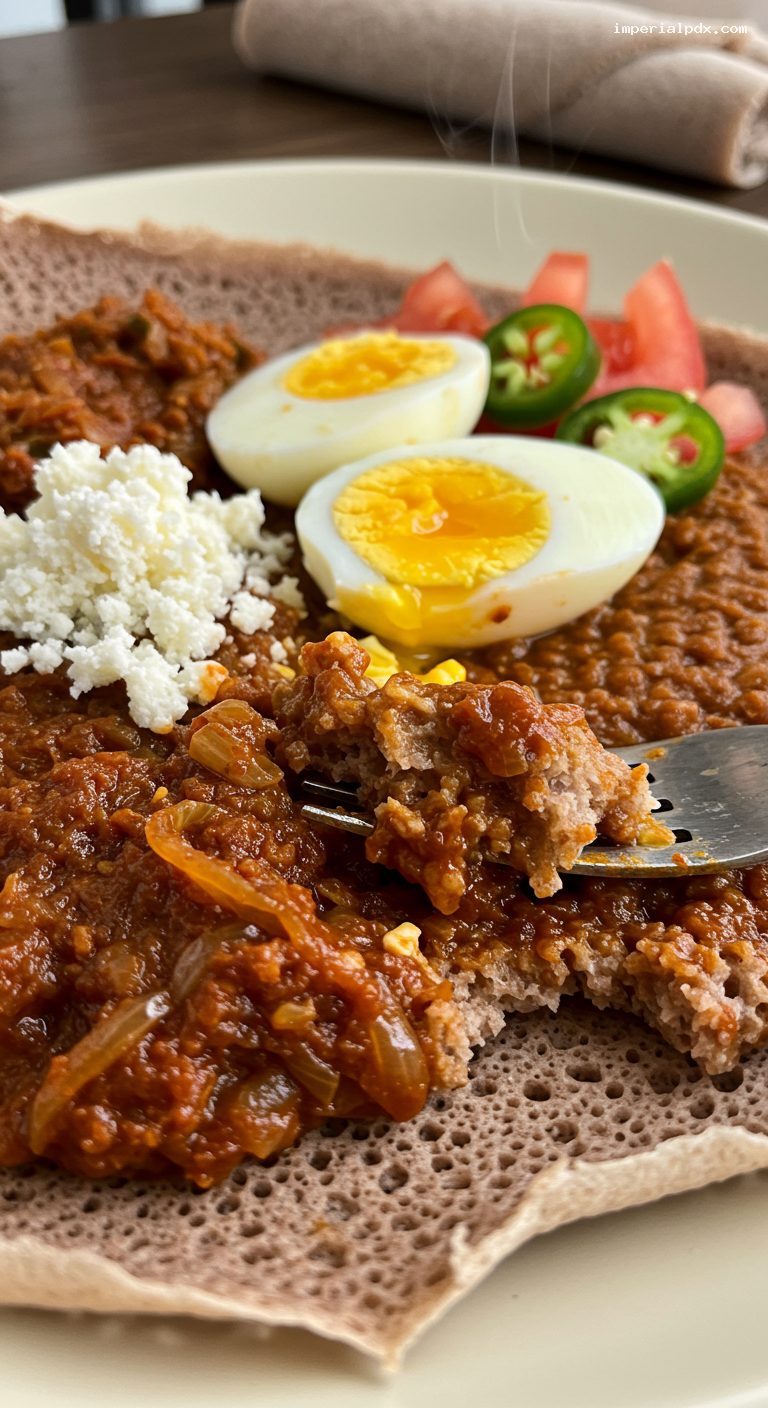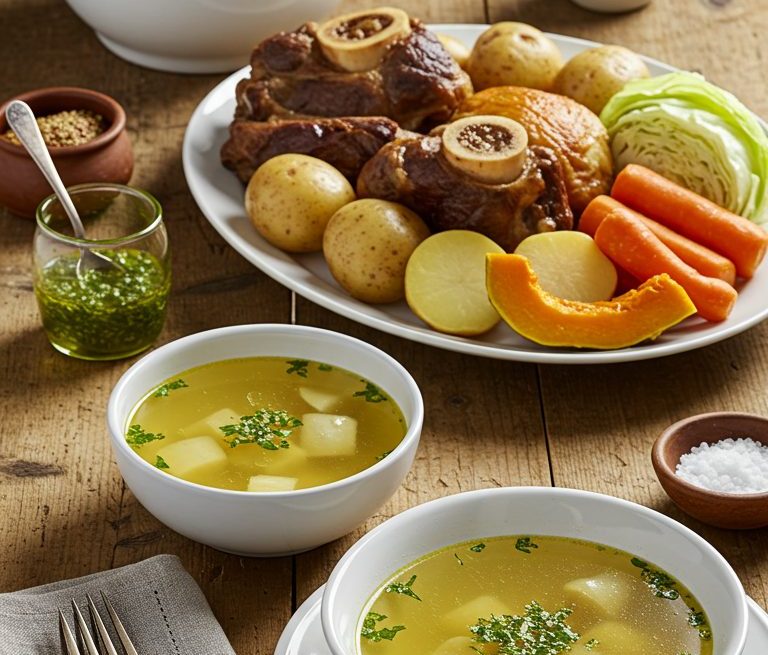Quick Recipe Version (TL;DR)
Quick Ingredients
- 3 large injera (about 450 g), torn into 1–2 inch pieces
- 3 tbsp niter kibbeh (Ethiopian spiced butter), or 2 tbsp unsalted butter + 1 tbsp neutral oil
- 1 large yellow onion, finely chopped (2 cups / 250 g)
- 3 cloves garlic, minced; 1 tsp grated fresh ginger
- 2–3 tbsp berbere spice blend
- 1 tbsp tomato paste
- 1 cup water or low-sodium broth, plus up to 1/2 cup more as needed
- 2 tbsp fresh lemon juice (or 1 1/2 tbsp apple cider vinegar)
- 1 tsp kosher salt, plus more to taste
- 1 cup crumbled ayib or farmer’s cheese (or well-drained ricotta/cottage cheese)
- 4 hard-boiled eggs, quartered
- Optional: 1 jalapeño (or green chili), thinly sliced; 1/4 tsp mitmita; extra melted niter kibbeh for drizzling
Do This
- 1. Boil eggs: Cover eggs with cold water by 1 inch; bring to a boil (212°F / 100°C), cover, simmer gently 10 minutes, ice-bath 5 minutes, peel, quarter.
- 2. Sweat onions: In a 12-inch skillet over medium heat, cook chopped onion dry 8–10 minutes, stirring; splash in 1–2 tbsp water if it sticks.
- 3. Build base: Add niter kibbeh; stir in garlic and ginger 30 seconds. Add tomato paste and berbere; cook 60 seconds.
- 4. Simmer sauce: Pour in 1 cup water/broth; simmer on medium-low (about 190–200°F / 88–93°C) 5–7 minutes until slightly thick.
- 5. Season and toss: Stir in salt and lemon juice. Add torn injera; fold gently over low heat 1–2 minutes, adding up to 1/2 cup water if dry.
- 6. Finish: Mound on a warm platter; top with ayib and egg wedges. Garnish with jalapeño, mitmita, and a drizzle of melted niter kibbeh. Serve warm.
Why You’ll Love This Recipe
- Deeply savory, tangy, and spicy—berbere and lemon balance buttery richness perfectly.
- One-pan and weeknight-friendly, yet special enough for brunch or guests.
- Flexible: make the sauce from scratch or toss injera into leftover key wat.
- Authentic touches (niter kibbeh and ayib) with easy substitutions for any kitchen.
Grocery List
- Produce: 1 large yellow onion, garlic, fresh ginger, 1 lemon, 1 jalapeño or green chili (optional)
- Dairy: Niter kibbeh (or unsalted butter), ayib/farmer’s cheese/ricotta/cottage cheese, eggs
- Pantry: Injera, berbere, tomato paste, kosher salt, neutral oil, low-sodium broth or water, mitmita (optional)
Full Ingredients
Berbere–Onion Base (make this if not using leftover key wat)
- 1 large yellow onion, finely chopped (2 cups / 250 g)
- 3 tbsp niter kibbeh (Ethiopian spiced clarified butter), or 2 tbsp unsalted butter + 1 tbsp neutral oil
- 3 cloves garlic, minced (10 g)
- 1 tsp finely grated fresh ginger (5 g)
- 2–3 tbsp berbere spice blend (to heat preference)
- 1 tbsp tomato paste (15 g)
- 1 cup water or low-sodium broth (240 ml), plus up to 1/2 cup (120 ml) more as needed
- 1 tsp kosher salt, or to taste
- 2 tbsp fresh lemon juice (30 ml), or 1 1/2 tbsp apple cider vinegar (22 ml)
If Using Leftover Key Wat (Beef Stew) Instead
- 2 to 2 1/2 cups warmed key wat (well-seasoned, saucy)
- Optional: 1–2 tbsp water or broth to loosen to a pourable sauce
- 1 tbsp fresh lemon juice, to balance richness
To Assemble & Finish
- 3 large injera (12–14 inches; about 450 g total), torn into 1–2 inch pieces
- 1 cup crumbled ayib or farmer’s cheese (about 150 g; or well-drained ricotta/cottage cheese)
- 4 large eggs, hard-boiled and cut into wedges
- Optional garnishes: 1 jalapeño or green chili, thinly sliced; 1 tbsp melted niter kibbeh; 1/4 tsp mitmita

Step-by-Step Instructions
Step 1: Cook and prep the eggs
Place the eggs in a saucepan and cover with cold water by 1 inch. Bring to a rolling boil (212°F / 100°C) over high heat. Immediately cover, reduce to a gentle simmer (about 190°F / 88°C), and cook for 10 minutes. Transfer to an ice bath for 5 minutes, then peel and cut into wedges. Set aside.
Step 2: Tear the injera
Tear the injera into 1–2 inch pieces and place in a large bowl. Day-old injera works best—it holds texture and drinks in sauce without turning gummy. Keep nearby; you will fold it in quickly at the end.
Step 3: Dry-sweat the onions
Set a 12-inch wide, heavy skillet over medium heat. Add the chopped onion without any fat and cook 8–10 minutes, stirring frequently. If the onion starts to stick or brown too fast, splash in 1–2 tablespoons of water to release. The onions should soften deeply and become sweet and jammy.
Step 4: Build the berbere sauce (or warm key wat)
Stir in the niter kibbeh (or butter and oil). Add the garlic and ginger; cook 30 seconds until fragrant. Mix in the tomato paste and berbere; stir and “bloom” the spices for 60 seconds. Pour in 1 cup water or broth and bring to a gentle simmer (190–200°F / 88–93°C) for 5–7 minutes until slightly thickened.
If using leftover key wat instead: Warm 2–2 1/2 cups key wat in the skillet over medium-low, loosen with 1–2 tablespoons water or broth to a spoonable, saucy consistency.
Step 5: Season and balance
Stir in 1 teaspoon kosher salt and the lemon juice (or vinegar). Taste—it should be bright, savory, and pleasantly spicy. Adjust salt, lemon, or berbere to preference. Aim for a sauce as thick as a loose tomato sauce; add up to 1/2 cup more water if needed.
Step 6: Fold in the injera
Reduce heat to low. Add the torn injera in two additions, gently folding with two spatulas so every piece is coated. The injera will quickly absorb liquid; splash in extra water or broth a few tablespoons at a time until the mixture is saucy but not soupy. Warm through for just 1–2 minutes—do not overcook or it will turn mushy.
Step 7: Finish and serve
Transfer to a warm wide bowl or platter. Top with crumbled ayib, nestle in the egg wedges, and garnish with jalapeño slices. Drizzle with a little melted niter kibbeh and dust with a pinch of mitmita if you like extra heat. Serve immediately while warm and saucy.
Pro Tips
- Dry-sweating onions before adding fat concentrates sweetness and gives firfir its signature depth.
- Bloom berbere briefly in fat to unlock aroma—60 seconds is enough to avoid bitterness.
- Use day-old injera; very fresh injera softens too fast. If your injera is very dry, add a bit more liquid to the sauce.
- Keep it saucy: injera continues to drink up liquid as it sits. Hold back some warm water/broth to loosen just before serving.
- Ayib is naturally mild, so season the sauce well. If substituting ricotta or cottage cheese, drain it to keep the dish from getting watery.
Variations
- Key Wat Firfir: Skip the onion base and warm 2–2 1/2 cups leftover key wat. Loosen with a splash of water, brighten with lemon, then fold in injera and finish as written.
- Vegetarian/Vegan Firfir: Use oil instead of niter kibbeh and finish with a drizzle of chili oil; skip eggs and top with ripe avocado slices and extra lemon.
- Egg-Scramble Firfir (Enkulal-style): Beat 4 eggs with a pinch of salt and scramble them into the sauce just before adding injera, then fold in injera and finish with ayib.
Storage & Make-Ahead
Firfir is best right after tossing, but you can make the berbere–onion sauce up to 3 days ahead (refrigerated) or freeze it for up to 2 months. Cook eggs up to 3 days ahead. Store leftover firfir in an airtight container, refrigerated, for up to 2 days; reheat gently in a skillet over medium-low with a splash of water and a little niter kibbeh until saucy again. Store eggs and cheese separately. Freezing assembled firfir is not recommended due to texture changes.
Nutrition (per serving)
Approx. 480 calories; 18 g fat; 56 g carbohydrates; 18 g protein; 5 g fiber; 720 mg sodium. Nutrition will vary with cheese choice and the amount of added fat and salt.



